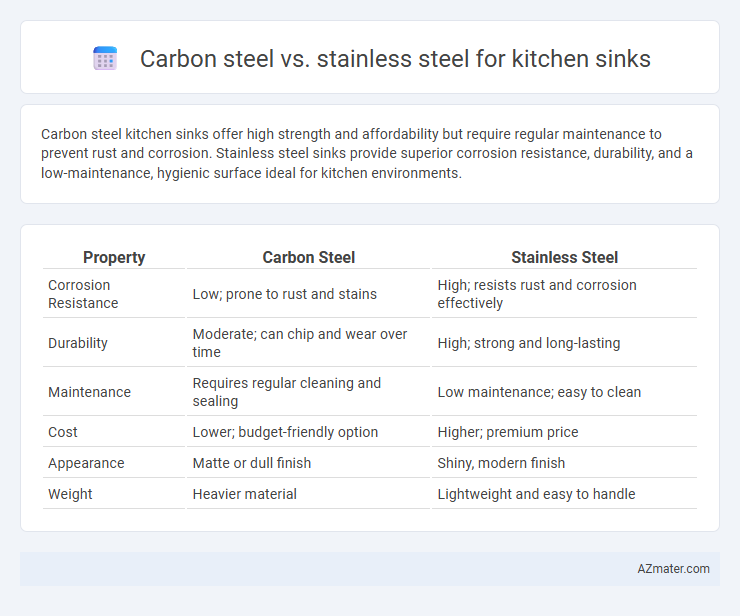Carbon steel kitchen sinks offer high strength and affordability but require regular maintenance to prevent rust and corrosion. Stainless steel sinks provide superior corrosion resistance, durability, and a low-maintenance, hygienic surface ideal for kitchen environments.
Table of Comparison
| Property | Carbon Steel | Stainless Steel |
|---|---|---|
| Corrosion Resistance | Low; prone to rust and stains | High; resists rust and corrosion effectively |
| Durability | Moderate; can chip and wear over time | High; strong and long-lasting |
| Maintenance | Requires regular cleaning and sealing | Low maintenance; easy to clean |
| Cost | Lower; budget-friendly option | Higher; premium price |
| Appearance | Matte or dull finish | Shiny, modern finish |
| Weight | Heavier material | Lightweight and easy to handle |
Introduction: Understanding Kitchen Sink Materials
Carbon steel kitchen sinks offer durability and affordability with a protective enamel coating that resists scratches and stains. Stainless steel sinks provide superior corrosion resistance and a sleek, modern look, making them a popular choice for kitchen environments. Selecting between carbon steel and stainless steel depends on factors such as maintenance preferences, budget, and desired aesthetic.
Key Differences Between Carbon Steel and Stainless Steel
Carbon steel kitchen sinks are known for their durability and excellent resistance to heat but may require frequent maintenance to prevent rust and corrosion, unlike stainless steel sinks which offer superior rust resistance and low maintenance due to their chromium content. Stainless steel sinks typically have a shinier appearance and are more resistant to stains and scratches, while carbon steel sinks provide a heavier, more solid feel but can be prone to discoloration over time. The difference in composition, with stainless steel containing at least 10.5% chromium, results in enhanced corrosion resistance compared to the primarily iron-carbon alloy of carbon steel sinks.
Corrosion Resistance: Which Steel Performs Better?
Stainless steel outperforms carbon steel in corrosion resistance due to its chromium content, typically 10.5% or higher, which forms a passive oxide layer protecting the surface from rust and stains. Carbon steel lacks this protective layer and is more susceptible to oxidation, especially in a moist kitchen environment. Choosing stainless steel for kitchen sinks ensures durability and long-term resistance to corrosion, maintaining both aesthetic appeal and structural integrity.
Durability and Strength Comparison
Carbon steel kitchen sinks offer exceptional strength and impact resistance, making them highly durable for heavy-duty use, but they require regular maintenance to prevent rust and corrosion. Stainless steel sinks, composed primarily of chromium and nickel, provide superior corrosion resistance and maintain their appearance with minimal upkeep, ensuring long-term durability in wet environments. While carbon steel can be stronger in terms of hardness, stainless steel's balanced strength and corrosion resistance make it the preferred choice for kitchen sinks in terms of lasting reliability.
Maintenance Requirements for Each Material
Carbon steel kitchen sinks require regular sealing and immediate drying to prevent rust and corrosion, with occasional application of protective coatings recommended to maintain their durability. Stainless steel sinks offer low maintenance, resisting stains and corrosion naturally, though periodic cleaning with non-abrasive cleaners helps preserve their shine and hygiene. Both materials benefit from avoiding harsh chemicals and abrasive pads to extend their lifespan and maintain surface quality.
Cost Analysis: Carbon Steel vs Stainless Steel Sinks
Carbon steel sinks typically cost less than stainless steel sinks due to lower raw material and production expenses. Stainless steel sinks, especially those with higher gauges and premium finishes, tend to have a higher upfront price but offer superior corrosion resistance and durability. When evaluating long-term costs, stainless steel sinks often provide better value through enhanced longevity and reduced maintenance requirements compared to carbon steel options.
Aesthetic Appeal and Design Options
Carbon steel kitchen sinks offer a sleek, industrial look with a matte or satin finish that complements modern and minimalist kitchen designs, while stainless steel sinks provide a versatile, polished appearance ranging from brushed to mirror finishes that suit various styles from traditional to contemporary. Stainless steel is available in a wider array of designs, including drop-in, undermount, and farmhouse styles, offering greater customization and seamless integration with countertops. Carbon steel sinks tend to have fewer design options but stand out with their bold, powder-coated colors and textured surfaces that add unique aesthetic appeal.
Hygiene Considerations in Kitchen Use
Stainless steel sinks offer superior hygiene due to their non-porous surface, which resists bacteria and makes cleaning easier compared to carbon steel. Carbon steel sinks, prone to rust and corrosion if not properly maintained, can harbor bacteria in damaged areas, raising hygiene concerns in kitchen use. The chromium content in stainless steel provides natural antimicrobial properties, ensuring a safer and more sanitary environment for food preparation.
Environmental Impact and Sustainability
Carbon steel kitchen sinks have a lower environmental impact due to their simpler manufacturing process and higher recyclability, reducing energy consumption and waste. Stainless steel sinks are highly durable and resistant to corrosion, which extends their lifespan, but their production involves more energy-intensive mining and processing of chromium and nickel. Choosing carbon steel can enhance sustainability through reduced resource extraction, while stainless steel offers longevity that supports waste reduction over time.
Conclusion: Choosing the Right Steel for Your Kitchen Sink
Carbon steel sinks offer superior strength and impact resistance, making them ideal for heavy usage and durability in busy kitchens. Stainless steel sinks provide excellent corrosion resistance, easy maintenance, and a modern aesthetic, suitable for environments prone to moisture and staining. Selecting the right steel depends on balancing durability needs with resistance to rust and ease of cleaning for optimal kitchen performance.

Infographic: Carbon steel vs Stainless steel for Kitchen sink
 azmater.com
azmater.com